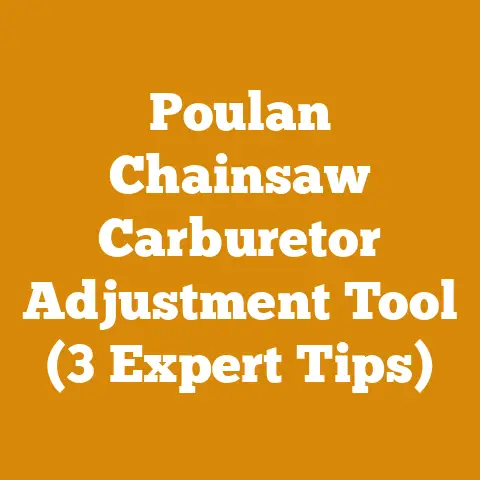Wood Chipper Bug (5 Hidden Risks You Must Know)
Imagine this: You’re feeding branches into your wood chipper, feeling productive, getting rid of yard waste, maybe even creating valuable mulch for your garden. Suddenly, the machine starts vibrating violently, spitting out wood chips at a strange angle. You quickly shut it down, but a nagging worry creeps in. What just happened? Could it have been worse? This scenario highlights the lurking dangers of a “wood chipper bug” – a term I use to describe unexpected malfunctions or hidden risks that can turn a useful tool into a hazard.
Over my years of experience in wood processing, from felling trees in the Pacific Northwest to preparing firewood in my own backyard, I’ve seen firsthand the damage a malfunctioning wood chipper can cause. It’s not just about the machine breaking down; it’s about the potential for serious injury or even death. This article will delve into five hidden risks associated with wood chippers that you absolutely need to know to stay safe and efficient. We’ll cover everything from proper maintenance to understanding the wood you’re chipping, arming you with the knowledge to avoid becoming a statistic.
The Wood Chipper Bug: 5 Hidden Risks You Must Know
Wood chippers are powerful machines designed to quickly reduce branches and small trees into manageable wood chips. However, their power also presents significant risks. These risks aren’t always obvious, and complacency can lead to accidents. Let’s break down the five key hidden risks:
1. Infeed Material Mayhem: The Unpredictable Feed
The first and perhaps most insidious risk lies in the material you’re feeding into the chipper. It’s not just about the size of the branch; it’s about the type of wood, its condition, and what might be hidden within it.
-
The Green Wood vs. Seasoned Wood Dilemma: Green wood, freshly cut, is significantly heavier and denser than seasoned wood. This means it requires more power to chip. Overloading your chipper with green wood can strain the engine, potentially causing it to stall or overheat. Seasoned wood, on the other hand, is lighter and easier to chip, but it can also be more brittle and prone to splintering.
- My Experience: I once tried to chip a large pile of freshly cut willow branches. The chipper, a 15-horsepower model, bogged down almost immediately. I had to reduce the feed rate significantly, making the job take far longer than expected. I learned that willow, with its high moisture content, requires a much more powerful chipper or needs to be seasoned before chipping.
- Data Point: Green wood can weigh up to twice as much as seasoned wood of the same species. This weight difference directly impacts the power required for chipping.
-
Hidden Debris: The Silent Saboteur: This is where things get really dangerous. Rocks, metal fragments (nails, screws, wire), and even clumps of dirt can be embedded in the wood. These foreign objects can wreak havoc on the chipper’s blades and internal components.
-
The Case Study of the Hidden Nail: A friend of mine was chipping branches after a storm. Unbeknownst to him, a small nail was embedded in one of the branches. As the branch entered the chipper, the nail struck the blade, causing a significant chip in the blade’s edge. The resulting imbalance caused the chipper to vibrate violently, and he narrowly avoided being struck by flying debris.
- Prevention is Key: Before feeding any material into the chipper, thoroughly inspect it for foreign objects. Use a metal detector if necessary, especially when dealing with wood from demolition sites or areas prone to litter.
-
Branch Structure and Feed Rate: The way you feed branches into the chipper is crucial. Feeding multiple small branches simultaneously can overload the machine. Large, forked branches can become lodged in the infeed chute, creating a dangerous situation.
-
The Proper Technique: Always feed branches one at a time, butt end first. This allows the chipper to process the material efficiently and reduces the risk of jams. For forked branches, cut them into smaller, more manageable sections before feeding them into the chipper.
- Tool Specification: A good pair of loppers (blade length 24-30 inches) is essential for trimming branches to the appropriate size.
-
Invasive Species and Seed Dispersal: Chipping invasive plant species can inadvertently spread their seeds, contributing to their proliferation.
-
The Buckthorn Blunder: Buckthorn, a highly invasive shrub, produces abundant seeds. Chipping buckthorn branches without taking precautions can spread these seeds far and wide.
- Containment Strategies: When chipping invasive species, consider bagging the wood chips immediately to prevent seed dispersal. Alternatively, solarize the wood chips by placing them in a black plastic bag and leaving them in the sun for several weeks. This will kill the seeds.
2. The Blade Balancing Act: Sharpness, Wear, and Tear
The blades are the heart of the wood chipper. Their condition directly impacts the machine’s performance and safety. Dull, chipped, or improperly balanced blades can lead to a variety of problems.
-
Dull Blades: A Recipe for Disaster: Dull blades require more force to cut through wood, putting extra strain on the engine and increasing the risk of kickback or jamming. They also produce larger, less uniform wood chips, which may not be suitable for all applications.
- The Sharpening Schedule: I recommend sharpening the blades after every 8-10 hours of use, or more frequently if you’re chipping particularly hard or abrasive wood.
- My Sharpening Method: I use a bench grinder with a fine-grit wheel to sharpen my chipper blades. It’s crucial to maintain the original bevel angle of the blade. Always wear safety glasses and gloves when sharpening.
-
Blade Imbalance: The Vibrating Hazard: Even slight imbalances in the blades can cause significant vibrations, which can damage the chipper’s bearings and other components. These vibrations can also make the machine difficult to control, increasing the risk of accidents.
-
The Weight Check: After sharpening, I always weigh the blades to ensure they are within a few grams of each other. If there’s a significant difference, I’ll grind down the heavier blade until it matches the weight of the lighter one.
- Professional Balancing: For optimal performance and safety, consider having your chipper blades professionally balanced by a qualified mechanic.
-
Blade Inspection: The Critical Step: Regularly inspect the blades for chips, cracks, and other damage. Replace any damaged blades immediately.
-
The Magnifying Glass Test: I use a magnifying glass to carefully examine the blades for hairline cracks, which can be difficult to see with the naked eye.
- Torque Specifications: When replacing blades, always use the correct torque specifications for the bolts. Overtightening can damage the bolts or the blades, while undertightening can cause the blades to come loose during operation.
-
Blade Material and Hardness: Different chipper models use blades made from different materials. Understanding the blade’s hardness is crucial for proper sharpening and maintenance.
-
The Rockwell Hardness Scale: Blade hardness is typically measured using the Rockwell hardness scale. Softer blades are easier to sharpen but wear out more quickly. Harder blades hold their edge longer but are more difficult to sharpen.
- Manufacturer’s Recommendations: Always follow the manufacturer’s recommendations for blade sharpening and replacement.
3. The Power Play: Engine Overload and Electrical Gremlins
Wood chippers are powered by either gasoline engines or electric motors. Both types of power sources can present risks if not properly maintained and operated.
-
Engine Overload: The Stalling Stallion: Overloading the engine with too much material or trying to chip wood that’s too large or dense can cause the engine to stall. Repeated stalling can damage the engine and potentially lead to a fire.
- The Load Management Strategy: I always listen to the engine as I’m feeding material into the chipper. If the engine starts to bog down, I immediately reduce the feed rate.
- Engine Size Matters: Choosing the right size chipper for the job is crucial. A small chipper may be adequate for small branches and twigs, but a larger chipper is needed for larger branches and small trees.
-
Electrical Hazards: The Shocking Truth: Electric chippers can present electrical hazards, especially in wet conditions. Damaged cords, faulty switches, and improper grounding can all lead to electric shock.
-
The Ground Fault Circuit Interrupter (GFCI): Always use a GFCI outlet when operating an electric chipper. A GFCI will automatically shut off the power if it detects a ground fault, preventing electric shock.
- Cord Inspection: Regularly inspect the power cord for damage. Replace any damaged cords immediately.
-
Fuel Storage and Handling: The Firestarter’s Kit: Gasoline-powered chippers require careful fuel storage and handling. Gasoline is highly flammable and can pose a fire hazard if not stored properly.
-
The Approved Container: Always store gasoline in an approved container, away from heat sources and open flames.
- Spill Prevention: Be careful not to spill gasoline when refueling the chipper. Clean up any spills immediately.
-
Exhaust Fumes: The Silent Killer: Gasoline-powered chippers produce exhaust fumes that contain carbon monoxide, a colorless and odorless gas that can be deadly.
-
Ventilation is Key: Always operate a gasoline-powered chipper in a well-ventilated area. Never operate it indoors or in an enclosed space.
- Carbon Monoxide Detector: Consider using a carbon monoxide detector when operating a gasoline-powered chipper, especially in partially enclosed spaces.
4. The Kickback Conundrum: Unpredictable Projectiles
Kickback occurs when the chipper suddenly ejects material back towards the operator. This can happen for a variety of reasons, such as feeding the wrong type of wood, overloading the machine, or encountering a hidden object.
-
The Physics of Kickback: Kickback is caused by the rotational force of the chipper blades. When the blades encounter resistance, they can suddenly fling material back towards the operator.
- The Angle of Attack: The angle at which you feed material into the chipper can affect the likelihood of kickback. Feeding material at an angle can increase the risk of the blades grabbing the material and ejecting it back towards you.
-
Guard Rails and Safety Barriers: The First Line of Defense: Most wood chippers are equipped with guard rails and safety barriers to protect the operator from kickback. It’s crucial to ensure that these safety features are in place and properly adjusted.
-
The Adjustment Process: Adjust the guard rails to the appropriate height for the material you’re chipping. The guard rails should be high enough to prevent material from being ejected back towards you, but not so high that they obstruct your view of the infeed chute.
- Never Disable Safety Features: Never disable or remove any of the chipper’s safety features. These features are designed to protect you from serious injury.
-
Personal Protective Equipment (PPE): Your Armor: Even with guard rails and safety barriers in place, it’s essential to wear appropriate PPE when operating a wood chipper.
-
Safety Glasses or Face Shield: Protect your eyes from flying debris.
- Hearing Protection: Wood chippers are noisy machines. Wear earplugs or earmuffs to protect your hearing.
- Gloves: Protect your hands from cuts and splinters.
- Long Sleeves and Pants: Protect your skin from flying debris.
- Steel-Toed Boots: Protect your feet from falling objects.
-
Operator Positioning: Staying Out of the Line of Fire: Position yourself to the side of the infeed chute, rather than directly in front of it. This will reduce your risk of being struck by kickback.
-
The Stance: Maintain a stable stance with your feet shoulder-width apart. This will help you maintain your balance if the chipper kicks back.
- Clearance Zone: Ensure that there is a clear area around the chipper, free of obstacles that could trip you or prevent you from moving quickly out of the way of kickback.
5. The Human Factor: Fatigue, Complacency, and Shortcuts
Ultimately, the biggest risk associated with wood chippers is the human factor. Fatigue, complacency, and taking shortcuts can all lead to accidents.
-
Fatigue: The Silent Impairment: Operating a wood chipper is physically demanding work. Fatigue can impair your judgment and slow your reaction time, increasing the risk of accidents.
- The Break Schedule: Take frequent breaks to rest and rehydrate. I recommend taking a 15-minute break every hour.
- Avoid Overexertion: Don’t try to work too long or too hard. If you’re feeling tired, stop and rest.
-
Complacency: The Danger of Routine: Complacency can set in when you’ve been operating a wood chipper for a long time. You may start to take shortcuts or ignore safety precautions.
-
The Checklist Mentality: Before each use, review the chipper’s safety procedures and inspect the machine for any potential problems.
- Stay Focused: Pay attention to what you’re doing and avoid distractions.
-
Shortcuts: The Path to Disaster: Taking shortcuts, such as disabling safety features or feeding the wrong type of wood, can significantly increase the risk of accidents.
-
No Shortcuts Allowed: Always follow the manufacturer’s instructions and safety procedures.
- Think Before You Act: Before taking any action, consider the potential consequences.
-
Communication and Teamwork: The Safety Net: If you’re working with a team, communicate clearly and coordinate your actions.
-
Hand Signals: Establish clear hand signals for communication, especially in noisy environments.
- Spotter: If possible, have a spotter watch for potential hazards and alert you to any problems.
-
Training and Education: The Foundation of Safety: Proper training and education are essential for operating a wood chipper safely.
-
Manufacturer’s Manual: Read and understand the manufacturer’s manual before operating the chipper.
- Safety Courses: Consider taking a safety course on wood chipper operation.
Concrete Examples from Real Projects:
Let’s look at how these principles apply in real-world scenarios:
Project 1: Clearing Storm Debris After a Windstorm:
After a recent windstorm in my area, I was hired to clear fallen branches and small trees from several properties. This project highlighted the importance of material inspection. Many branches contained hidden nails and debris from damaged fences and structures. Using a metal detector before chipping prevented damage to my chipper blades and potential kickback. I also encountered a large amount of green wood. By reducing the feed rate and allowing the engine to maintain its RPMs, I avoided overloading the machine.
Project 2: Processing Firewood from a Select Cut:
I recently harvested several trees from my property as part of a sustainable forestry project. The goal was to create firewood and wood chips for mulch. This project emphasized the importance of blade maintenance. The trees I harvested were a mix of hardwoods and softwoods. After chipping a significant amount of hardwood, I noticed the blades were becoming dull. Sharpening the blades before continuing with the softwood ensured a clean cut and prevented the chipper from bogging down.
Project 3: Chipping Invasive Species:
A local conservation group hired me to chip buckthorn and other invasive species from a nature preserve. This project highlighted the importance of containment. I bagged the wood chips immediately after chipping and transported them to a designated solarization area. This prevented the spread of invasive seeds.
Benefits and Strategic Advantages:
By understanding and mitigating these five hidden risks, you can:
- Reduce the risk of accidents and injuries: Safety is paramount. Protecting yourself and others from harm should be your top priority.
- Extend the life of your wood chipper: Proper maintenance and operation will help you avoid costly repairs and extend the life of your machine.
- Improve efficiency and productivity: By operating the chipper safely and efficiently, you can get the job done faster and with less effort.
- Create high-quality wood chips: Properly maintained blades and a controlled feed rate will result in uniform wood chips that are suitable for a variety of applications.
- Protect the environment: By preventing the spread of invasive species and using sustainable forestry practices, you can help protect the environment.
Practical Next Steps:
Now that you’re aware of these hidden risks, here are some practical steps you can take to improve your wood chipper safety:
- Read and understand your wood chipper’s manual: This is the most important step. The manual contains detailed information about the machine’s operation, maintenance, and safety procedures.
- Inspect your wood chipper before each use: Check the blades, engine, electrical components, and safety features.
- Wear appropriate PPE: Always wear safety glasses, hearing protection, gloves, long sleeves, pants, and steel-toed boots.
- Operate the chipper in a well-ventilated area: Avoid operating gasoline-powered chippers indoors or in enclosed spaces.
- Take frequent breaks: Avoid fatigue by taking regular breaks to rest and rehydrate.
- Never take shortcuts: Always follow the manufacturer’s instructions and safety procedures.
- Consider taking a safety course: A safety course can provide you with valuable knowledge and skills for operating a wood chipper safely.
Strategic Insights:
Beyond the tactical steps, consider these strategic insights:
- Invest in quality equipment: A well-built wood chipper with robust safety features is worth the investment.
- Develop a preventative maintenance program: Regular maintenance will help you identify and address potential problems before they become serious.
- Stay informed about safety standards: Keep up-to-date with the latest safety standards and regulations for wood chipper operation.
- Learn from your mistakes: Analyze any accidents or near misses to identify areas for improvement.
- Share your knowledge with others: Help promote wood chipper safety by sharing your knowledge and experiences with others.
By understanding and mitigating these five hidden risks, you can transform your wood chipper from a potential hazard into a valuable tool for wood processing and firewood preparation. Remember, safety is not just a set of rules; it’s a mindset. By adopting a safety-conscious approach, you can protect yourself, your equipment, and the environment.






